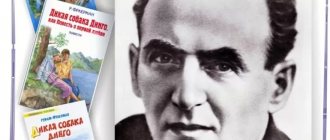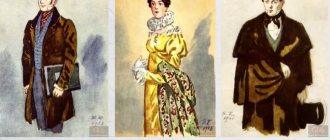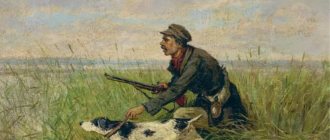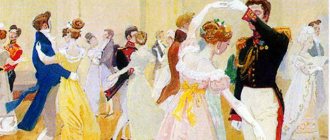About the product
“The Tale of Peter and Fevronia of Murom” by Ermolai Erasmus is a masterpiece of ancient Russian literature. The work was written in the middle of the 16th century on the basis of Murom oral traditions about the life of Peter and Fevronia, who ruled in Murom in the 13th century.
The plot is based on the legend of a wise peasant girl who became a princess. The story reflects many details of peasant and princely life.
For a reading diary and preparation for a literature lesson, we recommend reading online a summary of “The Tale of Peter and Fevronia of Murom” on our website.
The material was prepared jointly with a teacher of the highest category, Kuchmina Nadezhda Vladimirovna.
Experience as a teacher of Russian language and literature - 27 years.
Summary
Chapter 1
Once upon a time, the Russian city of Murom was ruled by a “noble prince named Pavel.” The devil, who had long hated the entire human race, decided to mock Paul. He sent a winged serpent to his wife “for fornication,” which appeared before her in the guise of the prince himself. This obsession continued for a long time, until one day the princess suspected something was wrong and told her husband about everything.
Pavel began to wonder how to deal with the seducer, but could not come up with anything worthwhile. Then he ordered his wife to find out from the serpent “why his death should happen.” She, through flattery, learned from the serpent that death was “destined for him from Peter’s shoulder and from Agrikov’s sword.”
Prince Pavel had a brother, Peter. Having learned about the cunning of the serpent, the fearless Peter was ready to immediately fight him, but “only one thing confused him - he did not know anything about Agric’s sword.” One day Peter went to pray at the “Church of the Exaltation of the Honest and Life-Giving Cross.” In the church he met a boy who invited him to look at Agrikov's sword. Peter happily agreed: now he can help his brother cope with the hated snake.
From then on, Peter began to look for a suitable opportunity to destroy the insidious serpent, which easily took on a princely appearance. Soon such a moment presented itself to Peter, and with all his strength he pierced the snake with Agric’s sword. He took “his natural appearance, trembled and died, sprinkling the blessed Prince Peter with his blood.” From that blood, Peter’s body was covered with painful ulcers that not a single doctor could cure.
Chapter 2
A serious illness overcame Peter, who grew weaker every day. Having learned “that there are many doctors in the Ryazan land,” he ordered to be taken there. Arriving at the place, Peter ordered his servants to find good doctors. One of them wandered into the house, where he met a wise maiden. She turned out to be Fevronia, the daughter of a poison dart frog who extracts wild honey. The servant told the girl about the prince’s suffering and asked her to name the worthy doctor. Fevronia ordered that the sick prince be brought to her, saying that “if he is sincere and humble in his words, he will be healthy.”
Peter was ready to generously reward the girl if she managed to cure him. However, Fevronia demanded a different payment from him: in case of recovery, the prince had to take her as his wife. “Prince Peter treated her words with disdain,” but pretended to agree with her condition. Fevronia handed over the leaven to the servants and ordered them to smear all the prince’s ulcers, except one.
Meanwhile, Peter decided to check whether Fevronia was as wise and smart as the servant told about her. He handed her a bunch of flax and ordered her to weave “a shirt, and clothes, and a scarf” from it while he was in the bathhouse. In response, the resourceful girl gave him a stump of log so that the prince could make a loom from it. Peter replied that this was impossible, to which Fevronia made him understand that she could not even sew clothes for an adult from a bunch of flax. Peter liked her answer.
The next morning the prince woke up completely healthy. He did not want to marry the dart frog’s daughter and, in gratitude, sent Fevronia rich gifts. But the girl didn’t accept them. When the prince went back to Murom, his whole body was again abundantly covered with painful ulcers. With shame, he returned to Fevronia. She healed him again and became his legal wife.
Chapter 3
After some time, Pavel died, and his brother Peter began to rule Murom. At the instigation of their wives, the boyars disliked Fevronia, “because she did not become a princess by birth,” and often slandered Peter about her. However, the prince never listened to the slander of the boyars and did not offend his beloved wife.
One day, the patience of the Murom boyars came to an end, and they openly told Peter that they did not want to see Fevronia as their princess. The nobles set a condition for him: if he wants to remain on the throne, then let him marry a worthy woman, and expel Fevronia from the city. They told Fevronia the same thing. The princess agreed to go home, but wanted to take with her only the only valuable thing - her husband. In turn, Peter, who “lived according to God’s commandments,” also did not want to be separated from his lawful wife. He voluntarily renounced the principality to the delight of the power-hungry boyars.
Peter and Fevronia sailed out of the city along the Oka, but already at the first stop the nobles from Murom caught up with them and began to beg them to return to reign. Many boyars were killed by the sword: each of them dreamed of the throne.
Upon returning to their hometown, the prince and princess began to rule again, “observing all the commandments and instructions of the Lord impeccably.” They were kind and fair rulers: “they received strangers, fed the hungry, clothed the naked, and delivered the poor from misfortunes.”
Chapter 4
In old age, feeling the imminent approach of death, the couple began to pray to God to die on the same day and hour. They bequeathed to bury themselves in coffins carved from a single stone, with a thin partition between them. Also, the couple simultaneously accepted “monasticism and donned monastic robes.” Peter was named David according to his monastic rank, and Fevronia was named Euphrosyne.
When Fevronia was “embroidering the faces of saints in the air for the cathedral church of the Most Pure Mother of God,” Peter sent for her. He said that he was ready to leave for another world. Fevronia finished her work and joined her husband. Having prayed together, the couple gave “their holy souls into the hands of God on the twenty-fifth day of the month of June.”
After the death of the princely couple, people buried Peter at the Cathedral Church of the Virgin Mary, and Fevronia in the Vozdvizhensky Convent. Imagine everyone’s surprise when the next morning the bodies of the couple were found “in their common coffin, which they ordered to be made for themselves during their lifetime.” Foolish people tried to separate them again, but in the morning history repeated itself, and the saints were found in the same place. After this, they no longer dared to touch their bodies and buried them “near the city cathedral church of the Nativity of the Holy Virgin, as they themselves commanded.” Since then, every believer could fall to their relics and receive healing.
Summary of “The Tale of Peter and Fevronia of Murom” by chapters
Chapter 1
The devil hated people and decided to do evil to the ruler of the city of Murom, Pavel. The Serpent seducer, sent by the devil, began to tempt Paul’s wife, disguised as her husband.
When the woman suspected something was wrong, she told everything as it was to her husband. He began to think about how to cope with the tempter. But nothing came to his mind. Then he asked his wife to find out from the serpent what his weakness was and how he could be killed.
The serpent, succumbing to the woman’s flattering speech, revealed the future that he would die at the hand of Peter, who would subdue him with Agric’s sword.
Peter is Paul's younger brother. When Paul recounted to him the insidious attacks of the serpent, Peter decided to defeat the tempter. But he had no idea where to get the Agric Sword.
One day, while in church, Peter met a boy who showed him the Agric sword. Peter realized that with this sword he could defeat the serpent.
The serpent constantly changed his appearance, turning into Paul. But one day Peter managed to waylay him and pierce him with a sword. The serpent immediately turned into his natural form and died. The blood from the blow of the sword splashed onto Peter, after which painful ulcers appeared throughout the young man’s body. No doctor can cure him of his painful illness.
Chapter 2
Peter had a hard time coping with his illness. His body was weakening every day, his life was fading away. Peter heard rumors about good doctors living in the Ryazan land, where he went.
The servants scattered to the houses of that area in search of a doctor. One of the servants entered the house where the girl Fevronia, the daughter of a poison dart frog, a wild honey miner, lived.
The servant told the girl how very ill his prince was and asked if she knew a good doctor to cure Peter.
The girl ordered the prince to be brought to her house and told him that she could heal him from painful ulcers. The prince was ready to do anything to pay the girl for healing, which he would not ask for.
But Fevronia did not ask for payment, but made the prince promise that he would marry her. Peter pretended to agree to this condition, although in his heart he treated such a proposal with disdain.
Fevronia ordered the servants to smear Peter with leaven for bread, but only ordered one ulcer not to be smeared.
The prince wanted to test the girl’s intelligence by giving her a piece of flax and ordered her to weave clothes for him in a short time. The girl was wise and in response gave him a log so that the prince would make her a loom on which she would weave clothes for him.
Peter said that this was not realistic, to which Fevronia said that she couldn’t make clothes that quickly without a machine. Peter really liked this answer.
And the next morning the prince had already recovered, but the prince did not want to marry the tree frog’s daughter and sent her rich gifts. Fevronia did not accept the gifts. And on the way back to Murom, Peter discovered that his whole body was again covered in ulcers.
Then the prince realized his mistake, returned for the girl and took her as his lawful wife. And the ulcers on his body disappeared immediately, and he himself recovered completely.
Chapter 3
Some time passed, Pavel died, and the rule of Murom passed to his brother Peter.
The boyars' wives began to slander their husbands about Fevronia, who from a simple peasant woman had turned into a princess. The boyars began to reprimand Peter that she was not a match for him. But Peter fell in love with his Fevronia and defended her from the boyars’ slander.
Then the boyars began to openly tell Peter that they did not want Fevronia to be a princess over them. The nobles set a condition for their prince that he must take a worthy wife and expel Fevronia. Or he will lose the throne.
And they told Fevronia that she was not worthy of being a princess and should leave Murom. The girl agreed to leave the city, but she must take one valuable thing that she values very much. This value for her was Peter.
The prince renounced the throne, took his beloved wife and sailed down the river.
But the nobles realized that they couldn’t live without Prince Peter. The boyars all fought for the right to sit on the princely throne. Then the nobles began to catch up with Peter and Fevronia, at the first stop they caught up with them and began to persuade them to return back.
The prince and princess returned to their hometown and began to rule further with all good behavior and impeccability. They were honest and decent rulers: they helped the poor, fed the hungry, and clothed the naked.
Chapter 4
The prince and princess grew old and began to turn to God in prayer so that they would die on the same day, so that they would not live without each other. They even ordered a single coffin for themselves with a thin partition between each other. Shortly before their death, they took monasticism and became David and Euphrosyne.
The time has come for the end of Peter's life, he sent a message to Fevronia that he was about to leave. Fevronia immediately completed her needlework and joined her husband. They prayed and died quietly and peacefully.
People did not bury them together, as was bequeathed by the spouses. But the next day everyone was amazed, as the bodies were reunited in a single coffin. Then people buried them separately again. But the next morning the bodies were together. Then they no longer separated them, but were buried together near the cathedral church, according to their lifetime command.
Conclusion
The story conveys the idea that one must keep one’s promise, be kind to different people, not turn away from the poor and needy, and honor God’s commandments.
Next, you can read a short retelling of “The Tale of Peter and Fevronia of Murom” or read the work in its full version.
That's all. Summary of “The Tale of Peter and Fevronia of Murom” for any educational purposes: very briefly, in detail and retelling with a mandatory test to check how well the material has been learned.





